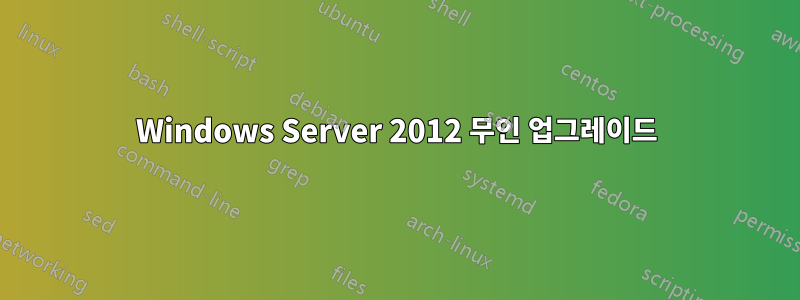
저는 Windows Server 소프트웨어를 처음 사용하고 있으며 현재 Windows Server 2008 R2 데이터 센터를 사용하고 있습니다. 2012년 서버로 업그레이드 하려고 합니다.
Windows 서버에서 무인 업그레이드를 어떻게 수행할 수 있습니까? 우리는 이 서버에 물리적으로 접근할 수 없습니다. 무인 설치(업그레이드가 아닌 디스크 삭제)를 수행하는 방법에 대한 지침을 찾았지만 어떻게 업그레이드할 수 있습니까?
답변1
위의 권장 사항에 따라 이것이 제가 한 일입니다.
- 가상 머신에 Windows Server 2008R2의 데모 버전을 설치했습니다.
- Windows Server 2012R2 데모 버전 획득
- 이 기사를 따랐다windows-서버-2012-무인(IP를 추가하려면 몇 가지 조정을 추가해야 했습니다)
이 사이트를 추가 속성에 대한 참조로 사용했습니다.Windows-서버-2012-자동-설치-설정
그리고 RDP 세션에서 자동으로 Windows 2008R2를 2012R2로 성공적으로 업그레이드할 수 있습니다.
간단히 말해서 단계는 다음과 같습니다.
- Windows ADK(평가 및 배포 키트)를 검색합니다(adksetup.exe 버전 8.100.26866 이상).
- 설치를 실행할 때 배포 도구 및 Windows PE(Windows 사전 설치 환경)를 선택합니다.
- 설치가 완료되면 Windows 시스템 이미지 관리자를 엽니다. (시작 메뉴에서)
- ISO에 액세스하고 install.wim 소스 파일(일반적으로 [iso]\sources 내부)을 찾아야 합니다.
- 이미지를 생성할 때 사용할 OS 버전을 선택해야 합니다.
- 이미지가 준비되면 구성에 다른 설정을 추가해야 합니다.
구성 샘플을 복사하고 이름을 지정합니다.Autounattend.xml필요에 따라 업데이트(도구 또는 메모장 사용, 도구 권장)하여 업그레이드를 실행하려면 다음이 필요합니다. [windows 소스]\setup.exe /unattend:"\path\OS\Autounattend.xml"
구성 샘플
<?xml version="1.0" encoding="utf-8"?>
<unattend xmlns="urn:schemas-microsoft-com:unattend">
<settings pass="specialize">
<component name="Microsoft-Windows-Shell-Setup" processorArchitecture="amd64" publicKeyToken="31bf3856ad364e35" language="neutral" versionScope="nonSxS" xmlns:wcm="http://schemas.microsoft.com/WMIConfig/2002/State" xmlns:xsi="http://www.w3.org/2001/XMLSchema-instance">
<ComputerName>mysuperComputer</ComputerName>
<ProductKey>123-1234-12345-12345-XXXX</ProductKey>
<RegisteredOrganization>Somewhere</RegisteredOrganization>
<RegisteredOwner>Me</RegisteredOwner>
<TimeZone>Pacific Standard Time</TimeZone>
</component>
<component name="Microsoft-Windows-TerminalServices-LocalSessionManager" processorArchitecture="amd64" publicKeyToken="31bf3856ad364e35" language="neutral" versionScope="nonSxS" xmlns:wcm="http://schemas.microsoft.com/WMIConfig/2002/State" xmlns:xsi="http://www.w3.org/2001/XMLSchema-instance">
<fDenyTSConnections>false</fDenyTSConnections>
</component>
</settings>
<settings pass="windowsPE">
<component name="Microsoft-Windows-International-Core-WinPE" processorArchitecture="amd64" publicKeyToken="31bf3856ad364e35" language="neutral" versionScope="nonSxS" xmlns:wcm="http://schemas.microsoft.com/WMIConfig/2002/State" xmlns:xsi="http://www.w3.org/2001/XMLSchema-instance">
<SetupUILanguage>
<UILanguage>en-US</UILanguage>
</SetupUILanguage>
<InputLocale>en-US</InputLocale>
<SystemLocale>en-US</SystemLocale>
<UILanguage>en-US</UILanguage>
<UserLocale>en-US</UserLocale>
</component>
<component name="Microsoft-Windows-Setup" processorArchitecture="amd64" publicKeyToken="31bf3856ad364e35" language="neutral" versionScope="nonSxS" xmlns:wcm="http://schemas.microsoft.com/WMIConfig/2002/State" xmlns:xsi="http://www.w3.org/2001/XMLSchema-instance">
<UserData>
<ProductKey>
<Key>123-1234-12345-12345-XXXX</Key>
<WillShowUI>OnError</WillShowUI>
</ProductKey>
<AcceptEula>true</AcceptEula>
<FullName>Me</FullName>
<Organization>Me</Organization>
</UserData>
<ImageInstall>
<OSImage>
<InstallFrom>
<MetaData wcm:action="add">
<Key> /IMAGE/NAME</Key>
<Value>Windows Server 2012 SERVERSTANDARD</Value>
</MetaData>
<Path>\\SOMESERVER\Windows Server\install.wim</Path>
</InstallFrom>
<InstallTo>
<DiskID>0</DiskID>
<PartitionID>1</PartitionID>
</InstallTo>
</OSImage>
</ImageInstall>
<DiskConfiguration>
<WillShowUI>OnError</WillShowUI>
<Disk wcm:action="add">
<CreatePartitions>
<CreatePartition wcm:action="add">
<Order>1</Order>
<Size>1000</Size>
<Type>Primary</Type>
</CreatePartition>
</CreatePartitions>
<ModifyPartitions>
<ModifyPartition wcm:action="add">
<Active>true</Active>
<Extend>true</Extend>
<Format>NTFS</Format>
<Letter>C</Letter>
<Order>1</Order>
<PartitionID>1</PartitionID>
</ModifyPartition>
</ModifyPartitions>
<DiskID>0</DiskID>
<WillWipeDisk>true</WillWipeDisk>
</Disk>
</DiskConfiguration>
<WindowsDeploymentServices>
<Login>
<Credentials>
<Password>thisisasecret</Password>
<Username>Administrator</Username>
</Credentials>
</Login>
</WindowsDeploymentServices>
<UpgradeData>
<Upgrade>false</Upgrade>
</UpgradeData>
</component>
<component name="Microsoft-Windows-TCPIP" processorArchitecture="amd64" publicKeyToken="31bf3856ad364e35" language="neutral" versionScope="nonSxS" xmlns:wcm="http://schemas.microsoft.com/WMIConfig/2002/State" xmlns:xsi="http://www.w3.org/2001/XMLSchema-instance">
<Interfaces>
<Interface wcm:action="add">
<Ipv4Settings>
<DhcpEnabled>true</DhcpEnabled>
</Ipv4Settings>
<Identifier>1</Identifier>
</Interface>
</Interfaces>
</component>
</settings>
<settings pass="oobeSystem">
<component name="Microsoft-Windows-Shell-Setup" processorArchitecture="amd64" publicKeyToken="31bf3856ad364e35" language="neutral" versionScope="nonSxS" xmlns:wcm="http://schemas.microsoft.com/WMIConfig/2002/State" xmlns:xsi="http://www.w3.org/2001/XMLSchema-instance">
<RegisteredOrganization>-</RegisteredOrganization>
<RegisteredOwner>-</RegisteredOwner>
</component>
</settings>
<cpi:offlineImage cpi:source="wim:c:/temp/install.wim#Windows Server 2012 R2 SERVERSTANDARD" xmlns:cpi="urn:schemas-microsoft-com:cpi" />
</unattend>
답변2
ISO 내용을 데스크탑에 복사하고 간단한 업그레이드 모드로 설치 프로그램을 실행함으로써 모든 Server 2008R2 DC 서버를 2012R2 DC로 업그레이드할 수 있었습니다. 무인 상태가 아니라는 것은 알지만 다시 시작해야 할 때까지는 연결이 유지됩니다. 5분 정도 기다리면 RDP를 다시 시작할 수 있습니다.
먼저 Windows 업데이트가 최신 상태인지 확인하고 싶을 것입니다. 그리고 최악의 경우를 대비해 백업을 먼저 수행하고 백업 복원을 위한 유지 관리 기간이 충분하지 않은 한 프로덕션 서버에서는 이 방법을 권장하지 않습니다.


